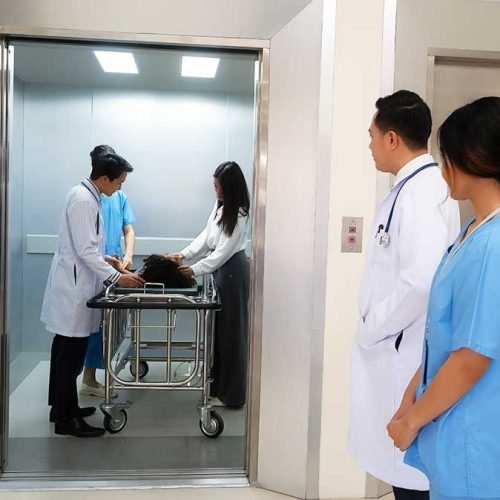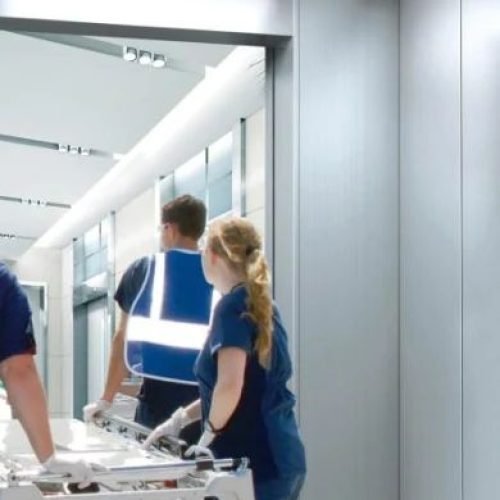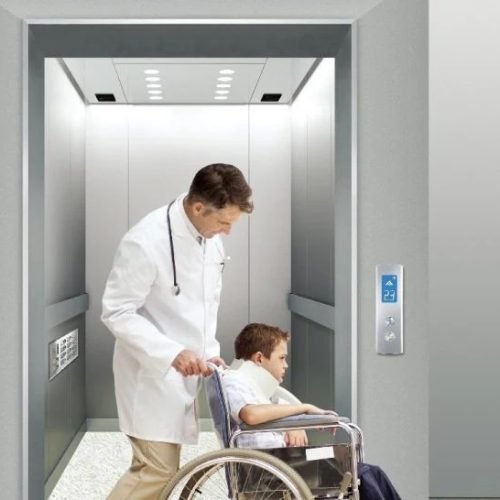Hospital Elevators



ProjectDetails
- Hospital Elevator
- Sidoarjo, East Java, ID
- March, 2019
- $250.000
- www.rudhisasmito.com
DownloadBrochure
General Information
Hospital elevators are a critical component of healthcare facilities, ensuring the efficient and safe movement of patients, staff, medical equipment, and visitors. Below is a comprehensive overview of hospital elevators, including their types, features, regulations, and considerations:
Hospital elevators are designed to meet specific needs within a healthcare environment. The main types include:
a. Patient Elevators**
– Designed to transport patients, often with beds or stretchers.
– Spacious to accommodate medical staff and equipment.
– Equipped with smooth and gentle ride features for patient comfort.
b. Service Elevators
– Used for transporting medical supplies, food, linens, and waste.
– Typically larger to accommodate carts and heavy equipment.
– May have separate access to avoid interference with patient transport.
c. Freight Elevators
– Heavy-duty elevators for moving large medical equipment, such as MRI machines or surgical tables.
– Designed to handle significant weight loads.
d. Staff Elevators
– Dedicated elevators for hospital staff to move quickly between floors.
– May have restricted access to improve efficiency.
e. Public Elevators
– For visitors and outpatients.
– Separate from patient and service elevators to reduce congestion.
Hospital elevators are equipped with specialized features to meet the unique demands of healthcare settings:
- a. Size and Capacity**
– Larger cabin sizes to accommodate stretchers, wheelchairs, and medical teams.
– High weight capacities for transporting heavy equipment. - b. Smooth Operation**
– Advanced control systems for smooth acceleration and deceleration, ensuring patient comfort. - c. Infection Control**
– Antimicrobial materials and easy-to-clean surfaces to maintain hygiene.
– Touchless controls (e.g., voice commands or smartphone apps) to reduce the spread of germs. - d. Emergency Features**
– Backup power systems to ensure operation during outages.
– Emergency communication systems for immediate assistance. - e. Accessibility**
– Compliance with ADA (Americans with Disabilities Act) or equivalent standards.
– Braille buttons, auditory signals, and low-height control panels for wheelchair users. - f. Advanced Technology**
– Destination dispatch systems to optimize traffic flow.
– Real-time monitoring and predictive maintenance to minimize downtime.
Hospital elevators must comply with strict regulations to ensure safety and reliability. Key standards include:
- a. ASME A17.1/CSA B44 (Elevator Safety Code):
– Governs the design, installation, and maintenance of elevators.
– Includes specific requirements for hospital elevators, such as emergency power and door safety. - b. ADA Compliance: – Ensures accessibility for individuals with disabilities. Requires features like tactile buttons, audible signals, and sufficient space for wheelchairs.
- c. NFPA 99 (Healthcare Facilities Code):
– Addresses fire safety and emergency power requirements for hospital elevators. - d. Local Building Codes:
– Vary by region but often include additional safety and accessibility requirements.
When designing or selecting hospital elevators, the following factors are critical:
- a. Traffic Flow:
– Efficiently managing the movement of patients, staff, and equipment.
– Separate elevators for different user groups to reduce congestion. - b. Zoning: Grouping elevators by function (e.g., patient, service, public) to optimize operations.
- c. Redundancy: Installing multiple elevators to ensure continuous operation in case of maintenance or breakdowns.
- d. Future Proofing: Designing elevators to accommodate future expansions or technological advancements.
Regular maintenance is essential to ensure the reliability and safety of hospital elevators:
- a. Routine Inspections:
– Conducted by certified technicians to identify and address potential issues. - b. Emergency Preparedness:– Regular testing of backup power systems and emergency communication systems.
- c. Staff Training:– Training hospital staff on proper elevator use and emergency procedures.
–
– **High Traffic Volume:** Hospitals experience constant elevator use, leading to wear and tear.
– **Infection Control:** Maintaining cleanliness in high-traffic areas.
– **Emergency Situations:** Ensuring elevators remain operational during power outages or disasters.
- – Smart Elevators: Use AI and IoT to optimize traffic flow and predict maintenance needs.
- – Touchless Controls: Reduce the spread of infections.
- – Energy Efficiency: Incorporate regenerative drives and energy-saving technologies.
The cost of hospital elevators depends on factors such as:
- – Type and capacity.
- – Customization (e.g., infection control features).
- – Installation complexity.
- – Maintenance requirements.
- – Otis Elevator Company
- – Schindler
- – Thyssenkrupp
- – KONE
- – Mitsubishi Electric
Conclusion
Hospital elevators are a vital part of healthcare infrastructure, requiring careful planning, advanced technology, and strict adherence to safety standards. By addressing the unique needs of hospitals, these elevators ensure efficient operations, patient comfort, and safety.
If you need more specific details or assistance with a particular aspect of hospital elevators, feel free to ask!
